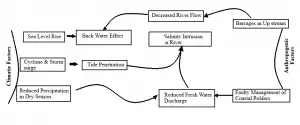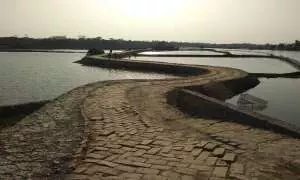Introduction:
Bangladesh coastline covers an area of around 710 kilometers on the Bay of Bengal flowing to the Indian Ocean. The ocean often threatens catastrophe for Bangladesh in the form of cyclones and tidal surge which is responsible for the sea level rise and sea level rise has various impacts on the coastal areas, such as land erosion, salinity-intrusion, and loss of biodiversity. However, among all these, the impact of salinity-intrusion is severe which brings a huge vulnerability to the coastal people. Observations in the recent past by SRDI in 2000 indicated that due to increasing intensity of salinity of some areas and expansion of salt affected areas normal crop production becomes more restricted in the coastal area. In this regard, soil salinity is believed to be mainly responsible for low land use as well as low crop intensity (Rahman and Ahsan, 2001). Moreover, Shrimp farming is a profitable business, most of the coastal polders constructed during the 1950s and 60s by the water development board to protect agricultural land from the inundation of salt water have now culture ghers (ponds) willingly being allowed in the ghers of the polder areas to raise shrimps. Unplanned and rapid expansion of shrimp farming in stand economic problems; most notable of them being destruction of mangroves and planktonic resources during collection of shrimp fry and environmental pollution.
Why is saline water intrusion a problem?
According to the World Health Organization (WHO) guidelines, human consumption of salt should not exceed 5 grams per day. Evidence for the relationship between high/excessive salt disease, strokes, and high blood pressure, has accumulated rapidly in the last few decades. In pregnant women excessive salt intake can cause gestational hypertension and (pre)eclampsia, the latter being one of the top five causes of direct maternal death.
In rural coastal Bangladesh, people eat few processed foods. However, drinking water in coastal regions has become extremely saline, such that people in the region get on average 50 – 100% of their recommended daily salt intake just from drinking water. Once dietary sodium is added to this, it is not difficult to see that the current salinity levels in drinking water have a significant impact on public health.
Study Area
The study was carried out in Ashashuni, Shyamnagar Upazila under Satkhira District as well as Koyra union under Khulna district of Bangladesh as they are known for worst salinity affected areas. I have conducted questionnaire survey of three days (21 February 2018- 24 February 2018). That survey included villages named Kurikaunia, Protapnagar, Kollanpur, Nakona, Bannatola, Khajra in Shyamnagar and Ashashuni, Satkhira as well as Gobindapur, Doshalia, Megharite, Atra in Koyra, Khulna.
Data Collection and Analysis:
The study was conducted mainly based on primary data sources. Secondary data has been also used from different journals, reports, research papers, websites and others published and unpublished documents of government and non-government. To collect primary data different methods had been adopted which were the informal interview, a pre-formulated questionnaire survey and Focused Group Discussion (FGD).
Possible Causes of Salinity:

Impacts of Salinity:

Farmers’ Responses to Salinity:
The farmers’ responses to salinity are not very encouraging. Survey findings indicate that they did not adopt any consistent strategy for coping with the salinity problem. There is no significant pattern in farmers’ responses to soil salinity. They use their lands for crop production which are located with minimal soil salinity. They try to diversify their production on these agricultural lands. They also emphasize on the need for more active government participation for solving the salinity problem. For example, installing a good drainage system is unavoidable for successful and sustainable reclamation. It is clear that farmers will not be able to install such a heavy drainage system without the help of government or NGO’s. The farmers also emphasize on maintaining the groundwater at a level where re-salinization can be maintained to a minimum level for a sustainable reclamation. They use deep wells for the irrigation. Riverbank erosion is a major hazard in the southern part of Bangladesh, in our survey we found most of the areas are affected by river bank erosion and some areas are facing this problem several times within a year. This creates a saline water intrusion in the agricultural lands and destroys the fertility of the land.

Photo: Irrigation by deep tubewell at Protapnagar village, Shyamnagar Upazila
Impacts of Shrimp Cultivation:
Over the last two decades, shrimp farming has emerged as a major industry in Bangladesh. Shrimp farming process starts from the input of saline water into fresh land previously used for agricultural production. The water is inundated and logged for a long time and shrimp fries are put into it. The shrimp prawns are grown up and take 3-6 months to be matured for catching. The saline water logging into fresh land degrades the soil quality of fresh lands that adversely affect on the local vegetation, plants and trees, crops, fishes, livestock, environment, ecology, and population health and diseases patterns. These effects ultimately accelerate the process of changes in the physical, aquatic and terrestrial environment, deforestation, biodiversity, ecosystems all of which change in climate and indoor environment of Bangladesh. All of these may have serious implications for sustainability as well.

Photo: Shrimp cultivation in Sanatankathi village, Ashashuni upazilla
Recommendations
More study and scientific research should be done for innovating and introducing salinity tolerant crop varieties.
Necessary steps should be taken to resist river bank erosion.
The government has to develop alternative livelihoods for the people who are the sufferer by the salinity intrusion problems.
Should be given more Emphasize on salinity issue in Integrated Coastal Zone Management (ICZM) Plan.
We have to Raise global awareness of the need to address vulnerability to salinity as sea-level is rising.
Have to incorporate drinking water crisis due to salinity in the National Water Policy.
Have to integrate coastal and marine management to face climate change related problems
References:
Karim Z., Hussain S.G. and Ahmed M. Salinity problems and crop intensification in the coastal regions of Bangladesh, Bangladesh Agricultural Research Council (BARC), Dhaka, Soils publication No. 33, 1990,SRDI, Soil Resource Development Institute (SRDI), Soil salinity in Bangladesh 2000 (Ministry of Agriculture, Government of the People’s Republic of Bangladesh, Dhaka, Bangladesh, 2000).Haider, M.Z. and Hossain M.Z. Impact of Salinity on Livelihood Strategies of Farmers, Journal of Soil Science and Plant Nutrition, Ali, A.K.S., Mohamed, B.F. and Dreyling, G. Salt Tolerance and Effects of Salinity on some Agricultural Crops in Sudan, Journal of Forest Products and Industries, Examining Salinisation Externalities in South India. South Asian Network for Development and Environmental Economics (SANDEE) Working Paper, No. 41Kathmandu, Nepal.
Chowdhury, M.A., Khairun, Y., Salequzzaman, M. and Rahman, M.M. Effect of Combined Shrimp and Rice on Water and Soil Quality in Bangladesh, Aquaculture International, 19, 2011, 1193 Miah, M.Y., Mannan, M.A., Quddus, K.G., Mahmud, M.A.M. and Baida, T. Salinity on Cultivable Land and Its Effects on Crops, Pakistan Journal of Biological Sciences, 7(8), 2004, Mahmuduzzaman, M., Ahmed, Z.U., Nuruzzaman, A.K.M., Ahmed, F.R.S. (2014).Causes of Salinity Intrusion in Coastal Belt of Bangladesh, International Journal of Plant Research. 4(4A), 2014, Hoque, M.A.A., Saika, U., Sarder, B.C. and Biswas, K.K. Environmental and Socio-economic impact of salinity intrusion in the Coastal Area: A Case Study on Munshigong Union, Shymnagor, Satkhira, Jahangirnagar University Environmental Bulletin https://www.researchgate.net/publication/303018298
Author:
Nahin Rezwan
Divisional Coordinator
Bangladesh Youth Environmental Initiative
Project Instructors:
1. Shukhen Goswami
Lecturer, Department of Geology and Mining, University of Barisal
2. Md. Ilias Mahmud
Lecturer, Department of Geology and Mining, University of Barisal
![]()
